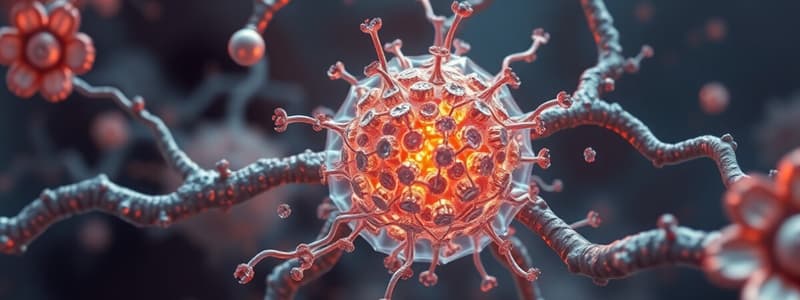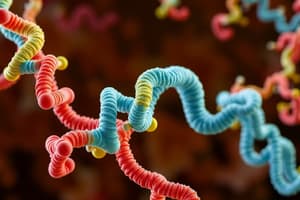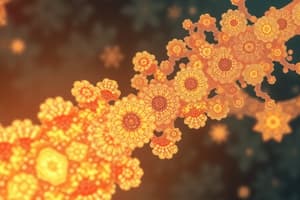Podcast
Questions and Answers
What binds to a receptor?
What binds to a receptor?
ligand
What are the two main things a ligand binding on a receptor can do?
What are the two main things a ligand binding on a receptor can do?
- Initiate a second messenger (correct)
- Decrease cell size
- Increase cell size
- Interact directly with DNA (correct)
Elements that regulate transcription long range are sometimes called ______ and are pieces of ______ that regulate transcription long range
Elements that regulate transcription long range are sometimes called ______ and are pieces of ______ that regulate transcription long range
enhancers, DNA
What is the main job of growth factors?
What is the main job of growth factors?
What type of toxins combine with critical molecular components or cellular organelles, disrupting function? Mercury is an example.
What type of toxins combine with critical molecular components or cellular organelles, disrupting function? Mercury is an example.
What type of toxins are converted from benign to reactive metabolites that act on target cells?
What type of toxins are converted from benign to reactive metabolites that act on target cells?
What are free radicals that are highly reactive and react with cellular components, destroying them?
What are free radicals that are highly reactive and react with cellular components, destroying them?
Which of the following are irreversible signs of cell damage? (Select all that apply)
Which of the following are irreversible signs of cell damage? (Select all that apply)
Which of the following statements correctly describes apoptosis and necrosis? (Select all that apply)
Which of the following statements correctly describes apoptosis and necrosis? (Select all that apply)
What is the term for increased cell size?
What is the term for increased cell size?
What is the term for a change in adult cell type?
What is the term for a change in adult cell type?
Hyperplasia alone is enough to cause cancer.
Hyperplasia alone is enough to cause cancer.
Which of the following can cause atrophy?
Which of the following can cause atrophy?
Which of the following are examples of metaplasia? (Select all that apply)
Which of the following are examples of metaplasia? (Select all that apply)
What is the term for disorderly proliferation of cells?
What is the term for disorderly proliferation of cells?
Where does ischemia usually occur?
Where does ischemia usually occur?
Ischemia in places that store glucose leads to a reliance on what?
Ischemia in places that store glucose leads to a reliance on what?
What is produced when glycogen is broken down anaerobically?
What is produced when glycogen is broken down anaerobically?
In the late stage of coagulative necrosis, what happens to membrane-bound organelles?
In the late stage of coagulative necrosis, what happens to membrane-bound organelles?
What happens to cellular architecture when cells burst?
What happens to cellular architecture when cells burst?
What rushes into cells when they burst during coagulative necrosis? (Select all that apply)
What rushes into cells when they burst during coagulative necrosis? (Select all that apply)
What part of the body is involved in liquefactive necrosis?
What part of the body is involved in liquefactive necrosis?
What happens to the pH in liquefactive necrosis?
What happens to the pH in liquefactive necrosis?
What fails during liquefactive necrosis?
What fails during liquefactive necrosis?
What is still active during liquefactive necrosis?
What is still active during liquefactive necrosis?
What is the description of a liquefactively necrotic cell under a microscope?
What is the description of a liquefactively necrotic cell under a microscope?
What results from caseous necrosis?
What results from caseous necrosis?
What surrounds the walls of a caseously necrotic cell?
What surrounds the walls of a caseously necrotic cell?
What are the two types of fat necrosis?
What are the two types of fat necrosis?
What dismantles triglycerides in adipose tissue during fat necrosis?
What dismantles triglycerides in adipose tissue during fat necrosis?
What is the process of making soap from salt and lipids?
What is the process of making soap from salt and lipids?
Flashcards
ligand
ligand
The thing that binds to a receptor.
ligand actions
ligand actions
A ligand can either initiate a second messenger or interact directly with DNA.
enhancers
enhancers
Elements regulating transcription long range, pieces of DNA.
growth factors
growth factors
Signup and view all the flashcards
direct-acting toxins
direct-acting toxins
Signup and view all the flashcards
latent toxins
latent toxins
Signup and view all the flashcards
reactive oxygen species
reactive oxygen species
Signup and view all the flashcards
irreversible signs of cell damage
irreversible signs of cell damage
Signup and view all the flashcards
apoptosis vs necrosis
apoptosis vs necrosis
Signup and view all the flashcards
hypertrophy
hypertrophy
Signup and view all the flashcards
hyperplasia
hyperplasia
Signup and view all the flashcards
atrophy
atrophy
Signup and view all the flashcards
metaplasia
metaplasia
Signup and view all the flashcards
dysplasia
dysplasia
Signup and view all the flashcards
ischemia
ischemia
Signup and view all the flashcards
lactate and pH from glycogen
lactate and pH from glycogen
Signup and view all the flashcards
late-stage coagulative necrosis
late-stage coagulative necrosis
Signup and view all the flashcards
inflammation manifestations
inflammation manifestations
Signup and view all the flashcards
chemokines
chemokines
Signup and view all the flashcards
TNF and IL-1 roles
TNF and IL-1 roles
Signup and view all the flashcards
prostaglandins functions
prostaglandins functions
Signup and view all the flashcards
serous inflammation
serous inflammation
Signup and view all the flashcards
exudate
exudate
Signup and view all the flashcards
NSAIDs role
NSAIDs role
Signup and view all the flashcards
macrophages function
macrophages function
Signup and view all the flashcards
scars formation
scars formation
Signup and view all the flashcards
chronic inflammation
chronic inflammation
Signup and view all the flashcards
fatty liver causes
fatty liver causes
Signup and view all the flashcards
granulomatous inflammation
granulomatous inflammation
Signup and view all the flashcards
peptic ulcers and kidney disease
peptic ulcers and kidney disease
Signup and view all the flashcards
Study Notes
Ligand Binding to Receptors
- Ligands bind to receptors
- Ligand binding can initiate second messengers
- Ligand binding can interact directly with DNA
Growth Factors and Toxins
- Growth factors prevent apoptosis
- Direct-acting toxins disrupt cellular function by binding to critical components or organelles(e.g., mercury)
- Latent toxins are initially benign but become reactive metabolites harming target cells
- Reactive oxygen species (ROS) are highly reactive free radicals damaging cellular components
Cell Damage and Death
- Irreversible cell damage includes the inability to restore mitochondrial function, loss of plasma membrane integrity, and loss of DNA/chromatin structure
- Apoptosis is programmed cell death (controlled) while necrosis is uncontrolled cell death often involving inflammation
- Cell size changes include hypertrophy (increased cell size), hyperplasia (increased cell number), atrophy (decreased cell size), and metaplasia (change in cell type)
Cell Damage and Cancer
- Hyperplasia alone does not cause cancer
- Atrophy can result from decreased workload, loss of innervation, poor blood supply, poor nutrition, or aging
- Metaplasia is seen in smokers' bronchi and Barrett's esophagus
- Dysplasia is disordered cell proliferation
- Ischemia, especially in glucose storage tissues, leads to reliance on glycogen for anaerobic metabolism, producing lactate, lowering pH, and denaturing proteins
- In coagulative necrosis, membrane-bound organelles burst, but the cellular architecture remains intact. Calcium, macrophages, and neutrophils rush in
Types of Necrosis
- Liquefactive necrosis (found in CNS) is characterized by maintaining constant pH, ATP pumps failing, organelle rupture, and active enzymes, resulting in a "moth-eaten" appearance under a microscope.
- Caseous necrosis forms granulomas (e.g., tuberculosis), surrounded by macrophages
- Fat necrosis can be enzymatic (e.g., pancreatic enzymes) or traumatic; it often leads to saponification (making soap from salt and lipids)
- Fibrinoid necrosis is a hypersensitivity reaction in blood vessels
- Eosinophils are often elevated in necrotic bloodwork
Apoptosis Mechanisms
- Intrinsic apoptosis involves mitochondria and is often triggered by embryonic development, lack of external survival signals, or P53 tumor suppressor activity.
- P53 activities include initiating DNA repair, arresting cellular respiration, or inducing BAD under high concentrations
- The BAD pathway involves BAD binding to BCL-2, allowing Bax/Bak to come together, releasing Cytochrome C, and initiating caspase activation for self-destruction.
- Extrinsic apoptosis is triggered by death receptors like TNF-α and Fas/Fas ligand, mainly in the thymus.
Inflammation
- Inflammation's cardinal signs are rubor (redness), calor (heat), tumor (swelling), and dolor (pain)
- Phagocytes and dendritic cells detect pathogens
- Cytokines (inflammation, antiviral interferons, and lymphocyte activators) are released
- Signals flow through the cytoplasm indicating problems. DNA breakdown is a signal.
- The inflammasome recruits leukocytes to respond to danger-associated molecular patterns (DAMPS).
- Inflammation leads to vasodilation and increased vascular permeability, causing exudate (high protein, cellular debris) to flow out of vessels. Transudate (low protein, cellular debris) results from normal blood vessel conditions.
- Histamine release from mast cells is a major driver of vasodilation
- The complement system functions in lysis, inflammation activation, opsonization, and immune clearance
- Cytokines activate endothelial cells for leukocyte adhesion, and chemokines attract leukocytes. TNF blockers (e.g., infliximab, adalimumab, etanercept) treat chronic inflammatory diseases
- Bradykinin is a vasoactive peptide causing vascular permeability and pain.
- Serous inflammation results from injury to serous epithelium, while fibrinous inflammation is a hallmark of chronic inflammation. Ulcers arise from sloughing of inflamed tissue, and granulomatous inflammation occurs when agents can't be eliminated. Septic shock is a massive cytokine response (TNF, IL-1)
- NSAIDs reduce prostaglandins to treat fever. Regenerative capacity depends on cell types' proliferative potential; the liver has regenerative capacity. Scars and macrophages are involved in ECM remodeling, with keloids being excessive ECM production. Persistent inflammation can cause extensive tissue loss and functional impairment (fibrosis).
Causes and Consequences of Cellular Changes and Inflammatory Processes
- Alcohol abuse, diabetes with obesity, and non-alcoholic steatohepatitis can cause fatty liver changes
- Anthracosis, a coal miner's lung, results from exogenous carbon.
Studying That Suits You
Use AI to generate personalized quizzes and flashcards to suit your learning preferences.




